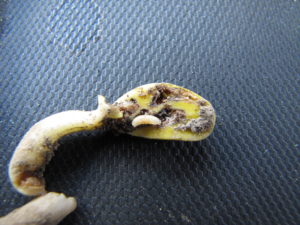Exeter Agribusiness Minutes
June 7, 2016
Malibu Restaurant, Exeter
Thank you to Pioneer for sponsoring breakfast. Robert Moloney chaired this meeting. The final meeting will be on June 24th starting at 7:00 am for breakfast (meeting starts at 7:30) at the Malibu.
Synopsis: Rainfall varied over the weekend (June 4-5) with most areas receiving between 0.5 inches and 1.0 inches of rain. There was one report of 2.5 inches in the Ridgetown area and a few reports of very little rain. Rain was quite variable in Lambton and things are still dry. Everyone that received rain was very relieved as conditions were getting extremely dry. This moisture will go a long way to help plant stands in fields that were crusted or the seed was not fully planted into moisture. A small amount of hail was reported north of London. There is replanting going on this week. Soybeans planted just before the cold rainy weekend starting on May 13th have suffered the most. Sandy soils are more of a problem as are tilled fields in that planting window. Agricorp has received about 400 calls of damaged crops many of those being poor soybean stands. Only about 25% of growers have reported their planted acreage to date. Please remind growers to call in their acreage. There is a pocket of severe seed corn maggot feeding around Teviotdale, as well as individual fields reported around Strathroy and Clinton. See picture. Replanting is underway. There are reports of significant grub and wireworm damage in fields but overall there have been fewer service calls this spring than other years. Crops look relatively good in this area. There was a report that fields further south in Elgin cou nty are patchy with poor stands on the knolls. About 75 percent of edible beans are planted. Some growers are waiting on moisture before planting.
nty are patchy with poor stands on the knolls. About 75 percent of edible beans are planted. Some growers are waiting on moisture before planting.
Wheat: Stripe rust is widespread. If the field was sprayed with a fungicide early disease control has been excellent. The early spray saved the day this year since stripe rust became so prevalent. Fungicides will hold the disease back for about 3 weeks. As temperatures increase into the summer stripe rust will be less of an issue. Fusarium spraying is now complete and essentially all fields in the area got sprayed for fusarium. High yield potential has encouraged those growers that don’t always spray to get the job done this year. Sulphur applied late this year barely had time to alleviate symptoms. There are still fields showing sulphur deficiency now. There can be up to a 45% yield hit if the problem is not corrected. These areas are also more susceptible to rust. Is it possible that manure has less S now? Historically, manure is considered to supply between 1 to 1.5 lbs/tonne. The amount has always ranged greatly so it’s difficult to know if values are actually declining. A good representative manure sample is important when sending in samples for lab analysis.
Corn: There was a discussion that corn plants have uneven emergence this year. This is likely associated with poor seed to soil contact. Cover crops are being seeded this week into the corn crop. Sulphur deficiency is quite evident in some fields. It may be appropriate to add sulphur to side-dress N application in those fields that get side-dressed. PSNT testing will start in earnest this week. Callisto “flash” is evident on overlaps. There are hybrid differences. Lower spray water volumes will increase the likelihood of burn. (less than 10 gallons/acre) As the corn plant metabolizes the product they will green up. This usually takes 7 to 10 days. Horsetail is becoming more prevalent. This is likely due to the increased use of glyphosate. Post-emergent horsetail control is a challenge. Broadstike plus MCPA is effective but watch crop safety. Since horsetail is usually localized within a field treating patches is a good option. Some growers feel they get some suppression with very high rates of roundup.
Soybeans: The normal mortality in soybeans is 20%. A germination rate of 90% multiplied by an emergence rate of 90% equals an 81% plant stand. Ontario trials have shown that a 75% stand in no-till and an 80% stand in conventional tillage is quite normal. With the dry conditions this spring no-till stands are actually better in many cases this spring. There are a few fields being planted into soybeans after hay harvest. This could also be a good year for double cropping opportunities if the wheat comes off early. Pre-emergent herbicides are struggling to hold back weeds with the dry conditions. Foxtails are coming along very quickly. The “reach-back” for pre-emergent herbicides varies greatly depending on the product. Group 15 herbicides can take down 1 leaf foxtail and maybe 2 leaf under the right conditions. If the ground is completely water saturated 3 leaf foxtail may be taken out. If weeds are easily identifiable when walking through a field without bending down the reach-back will not be enough. A post-emergent application should go on now for IP beans. Soil applied herbicides will still do a good job of keeping fields clean once it rains.
Agricorp:
May 1: New applications and coverage changes
June 15: Last day to report unseeded acreage.
June 30: Spring seeded final acreage reports due.
July 10: Premiums
CropLine – 1-888-449-0937
Field Crop News Website – https://fieldcropnews.com/
Upcoming Events
Southwest Crop Diagnostic Days – July 6 and 7, 2016
FarmSmart Expo – July 14
Eastern Crops Day – July 28
Stratford Crop Technology Contacts:
Horst Bohner, horst.bohner@ontario.ca
Joanna Follings, joanna.follings@ontario.ca
Meghan Moran, meghan.moran@ontario.ca
Jake Munroe, jake.munroe@ontario.ca
